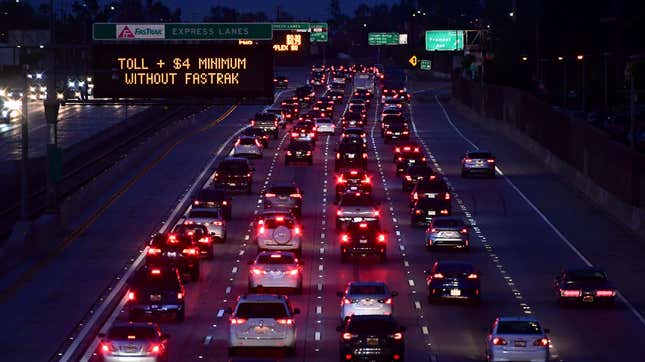
New research shows we have to start getting cars off the road—and fast—if we want to avoid cities being overrun by gridlock.
In the study published in the journal Open Science on Tuesday, researchers modeled city residents’ personal decisions of how to travel across a town. Understanding how cars affect cities and commute times is of vital importance, both for the sake of the climate—transportation is the biggest share of U.S. emissions and a growing chunk globally—and quality of life.
Right now, more than 80 million cars are produced worldwide each year. Absurdly, that means they’re increasing as fast as the global population. A bipartisan group of senators and President Joe Biden also just endorsed an infrastructure deal with $109 billion for roads and other auto-related infrastructure. While the U.S. admittedly needs some upgrades, doing so could perversely lock in more car use that the new study shows could be a catastrophe.
The researchers modeled the time car trips take, factoring in the baseline length of the trip on empty streets, the time added by other drivers who create traffic, and the time added by the designation of some street lanes for exclusive use by pedestrians, buses, and bikes. They also did the same for public transit, which in the study, includes biking and walking as well.
The model showed a phenomenon anyone who’s driven in a city is surely familiar with: This choice creates an inherent paradox. If more people decide that driving is quicker, there will be more traffic, clogging streets and making trips longer. The longest trips across town, the authors found, were the ones taken when every single resident tries to reduce their commute times by driving, thus creating the most traffic.
The study admits that the models are in some ways reductive. For one, it assumes that city populations are homogeneous and that all residents have equal access to all modes of transport without factoring in things like cost or the inequitable distribution of bike lanes. It also lumps together walking, biking, and all forms of public transit.
“Of course in real life, cycling may take a different length of time than the monorail,” Rafael Prieto Curiel, a postdoctoral researcher at the Mathematical Institute of the University of Oxford and the study’s lead author, said. “But also, let’s be honest, what happens today is that using public transport ... can require a bit of other things, like usually a bit of walking or a bit of cycling to the bus.”
But despite its simplistic nature, the model is instructive, showing the logical fallacy of attempting to reduce drive times by increasing the use of cars.
The authors also discuss some ways to reduce the time it takes to get across a city and lower carbon pollution, including investing in more reliable and quick public transit, building more bike lanes and walking paths, and not separating residential areas from commerce. They also suggest reducing the number of traffic lanes in cities and building less parking to discourage people from driving or even owning a car in the first place, making city travel faster for everyone. These ideas have been around in some form for years and even been implemented in some cities in an attempt to meet climate goals and cut air pollution (and help residents during the pandemic).
But more widespread adoption faces political challenges, the study notes, because in many cities worldwide, “policymakers are inclined to construct even more car infrastructure and invest even more in private cars, which then creates more incentives for private vehicle use and results in even more congestion.” In Latin America, where all the authors come from, this issue is particularly urgent because as income levels are increasing in cities, more people are choosing to buy cars. The same is true in burgeoning cities in Africa and Asia such as Lagos and Dhaka. If policies are put in place soon to make cities more pedestrian- and transit-oriented, it could set those and other cities on a path to more congestion and all its attendant issues.
“The impact is super pollution, congestion, so much time to go short distances. This is a tragedy,” said Curiel. “In a megacity with 50 million people and 50 million cars, which is where we are headed, it will be impossible to move. I mean, that’s not even a city. That’s a parking lot.”
Correction, 6/25/21, 1:50 p.m.: This post has been updated to reflect Dhaka is in Asia. Our editor was thinking of Dakar and apologizes for the confusion.